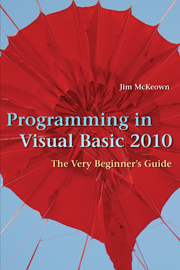Book contents
- Frontmatter
- Contents
- Preface
- 1 Fundamentals of Design and Programming – Starting from Scratch
- 2 Variables and Constants – A Place for Everything and Everything in Its Place
- 3 Writing Programs – First You Walk, Then You Run
- 4 Writing Programs II – More Controls and New Logic
- 5 Using If and Case – Decisions, Decisions, Decisions
- 6 Loops – Once Is Not Enough
- 7 Procedures and Functions – Divide and Conquer
- 8 Writing Programs III – Tying It All Together, So Far
- 9 File I/O – Files and Records and Fields, Oh My!
- 10 Arrays and Structures – Organizing Data
- 11 Events and More Controls – Tips and Tricks for Programming
- 12 Objects and Classes – Objects Are in a Class By Themselves
- 13 Graphics – The Visual (and Audio) Side of Visual Basic
- 14 LINQ to SQL – The World Runs on Databases
- 15 Crystal Reports – Tying Databases to Output
- Appendices
- Index
15 - Crystal Reports – Tying Databases to Output
Published online by Cambridge University Press: 05 June 2012
- Frontmatter
- Contents
- Preface
- 1 Fundamentals of Design and Programming – Starting from Scratch
- 2 Variables and Constants – A Place for Everything and Everything in Its Place
- 3 Writing Programs – First You Walk, Then You Run
- 4 Writing Programs II – More Controls and New Logic
- 5 Using If and Case – Decisions, Decisions, Decisions
- 6 Loops – Once Is Not Enough
- 7 Procedures and Functions – Divide and Conquer
- 8 Writing Programs III – Tying It All Together, So Far
- 9 File I/O – Files and Records and Fields, Oh My!
- 10 Arrays and Structures – Organizing Data
- 11 Events and More Controls – Tips and Tricks for Programming
- 12 Objects and Classes – Objects Are in a Class By Themselves
- 13 Graphics – The Visual (and Audio) Side of Visual Basic
- 14 LINQ to SQL – The World Runs on Databases
- 15 Crystal Reports – Tying Databases to Output
- Appendices
- Index
Summary
VB Quip
Man is still the most extraordinary computer of all.
– John F. KennedyThe world runs on databases. Data of all kinds are tracked and stored, managed, massaged, manipulated, and, sometimes mangled. You got of taste of that in the last chapter. You even saw a little of it with control breaks back in Chapter 9. A report is the key tool for managing data. With a report, data become information, a list of numbers becomes a total or an average, and meaningless figures become a report, complete with a colored chart. Crystal Reports is a full-featured database reporting tool from Business Objects®. It crunches the numbers and produces printable reports. It's one of literally hundreds of third-party add-ons for Visual Studio. It handles data from almost any database and integrates it into reports.
VB Tip
Crystal Reports works with the Professional version of Visual Studio. It will not work with the Express Edition. A thirty-day free trial of Crystal Reports is available from SAP at http://www.sap.com/solutions/sapbusinessobjects/index.epx
Crystal Reports Tutorial
VB Tip
Place the database files in a folder on your hard drive called C:\CRFiles. That makes your reports easily portable.
Be sure to use the Professional version of Visual Studio and have either the trial version or the full version of Crystal Reports installed on your system. Make sure the TouristStops.mdb database is in the C:\CRFiles folder on your system. TouristStops is an Access database that contains information on vacation spots throughout the United States.
- Type
- Chapter
- Information
- Programming in Visual Basic 2010The Very Beginner's Guide, pp. 601 - 630Publisher: Cambridge University PressPrint publication year: 2010



